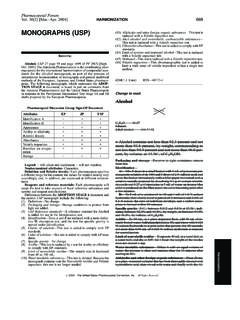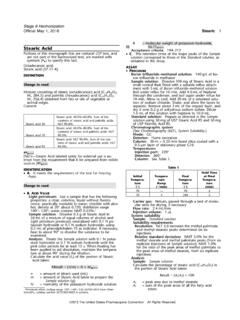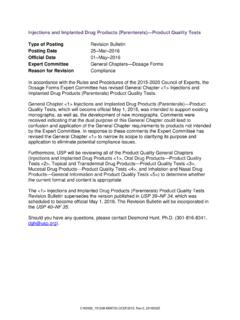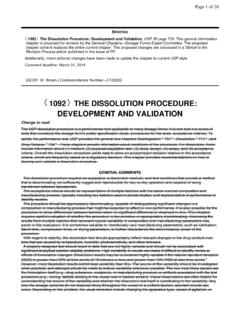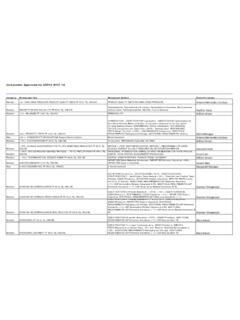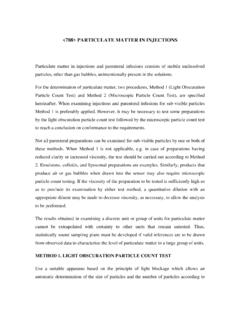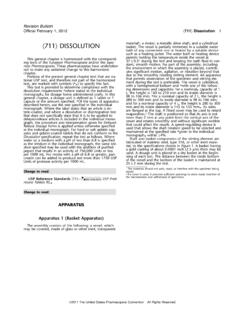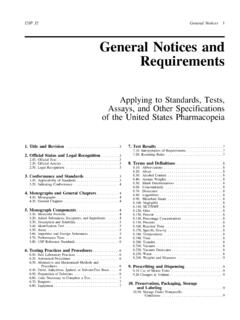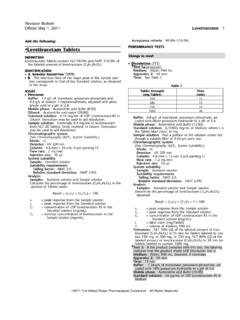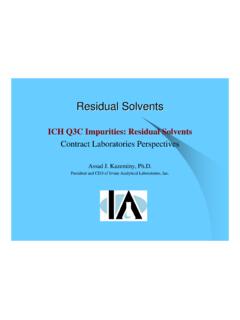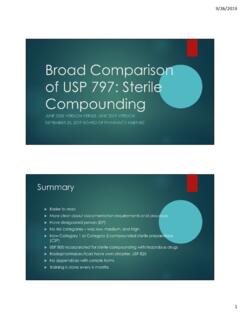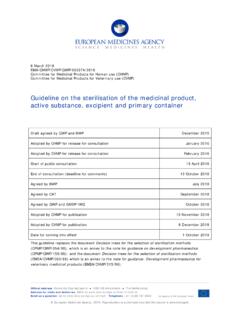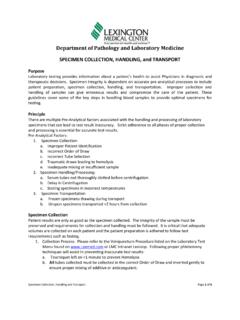Transcription of 797 PHARMACEUTICAL COMPOUNDING—STERILE …
1 <797> PHARMACEUTICAL Compounding sterile Preparations Type of Posting Revision Bulletin Posting Date 22 Nov 2019. Official Date 01 Dec 2019. Expert Committee Compounding Reason for Revision Compliance Postponement In accordance with the Rules and Procedures of the 2015 2020 Council of Experts, USP is postponing the official date of PHARMACEUTICAL Compounding sterile Preparations <797>. After publication of the revised <797> on June 1, 2019, USP received appeals on certain provisions of the chapter. In accordance with USP's Bylaws, the responsible Expert Committees worked with a sense of urgency to consider the information raised in the appeals and issued decisions on the appeals. As part of the formal USP appeals process, stakeholders who submitted appeals to the compounding chapters had the opportunity to request further review by an appointed Panel, and USP has received three (3) such requests on <797>. In light of these appeals, and in accordance with our Bylaws, USP is postponing the official date of <797> until further notice.
2 In the interim, the currently official version of <797> (last revised in 2008). including the section Radiopharmaceuticals as CSPs will remain official. The decisions on the appeals to <797> do not foreclose the possibility of future revisions to this chapter. Should you have any questions, please contact Jeanne Sun, Senior Manager, Healthcare Quality and Safety C242016-M99925-CMP2015, rev. 00 20191122. Revision Bulletin 797 1. Official December 1, 2019. Change to read: . 797 PHARMACEUTICAL COMPOUNDING sterile PREPARATIONS. The official date for this chapter is postponed until further notice. When the official date is reestablished, the period allowed for implementation will not be less than six months. TABLE OF CONTENTS. 1. INTRODUCTION AND SCOPE. Scope Administration Immediate Use CSPs Preparation Per Approved Labeling CSP Categories 2. PERSONNEL TRAINING AND EVALUATION. Demonstrating Proficiency in Core Competencies Demonstrating Competency in Garbing and Hand Hygiene Competency Testing in Aseptic Manipulation 3.
3 PERSONAL HYGIENE AND GARBING. Personnel Preparation Hand Hygiene Garbing Requirements 4. FACILITIES AND ENGINEERING CONTROLS. Protection from Airborne Contaminants Facility Design and Environmental Controls Creating Areas to Achieve Easily Cleanable Conditions Water Sources Placement and Movement of Materials 5. CERTIFICATION AND RECERTIFICATION. Total Airborne Particle Sampling 6. MICROBIOLOGICAL AIR AND SURFACE MONITORING. General Monitoring Requirements Monitoring Air Quality for Viable Airborne Particles Monitoring Surfaces for Viable Particles 7. CLEANING, DISINFECTING, AND APPLYING SPORICIDAL AGENTS IN COMPOUNDING AREAS. Cleaning, Disinfecting, and Sporicidal Agents Cleaning Supplies Cleaning, Disinfecting, and Applying Sporicidal Agents in the PEC. 8. INTRODUCING ITEMS INTO THE SEC AND PEC. Introducing Items into the Cleanroom Suite and SCAs Introducing Items into the PEC. Use of sterile 70% IPA on Critical Sites within the PEC.
4 9. EQUIPMENT, SUPPLIES, AND COMPONENTS. Equipment Supplies Components 10. STERILIZATION AND DEPYROGENATION. Depyrogenation Sterilization by Filtration Sterilization by Steam Heat Sterilization by Dry Heat 11. MASTER FORMULATION AND COMPOUNDING RECORDS. Creating Master Formulation Records Creating Compounding Records 12. RELEASE INSPECTIONS AND TESTING. Visual Inspection Sterility Testing Bacterial Endotoxins Testing 2019 The United States Pharmacopeial Convention All Rights Reserved. C242016-M99925-CMP2015, rev. 00 20191122. 2 797 Revision Bulletin Official December 1, 2019. 13. LABELING. 14. ESTABLISHING BEYOND-USE DATES. Terminology Parameters to Consider in Establishing a BUD. Establishing a BUD for a CSP. Multiple-Dose CSPs 15. USE OF CONVENTIONALLY MANUFACTURED PRODUCTS AS COMPONENTS. Use of Conventionally Manufactured Single-Dose Containers Use of Conventionally Manufactured Multiple-Dose Containers Use of Conventionally Manufactured Pharmacy Bulk Packages 16.
5 USE OF CSPs AS COMPONENTS. Use of Compounded Multiple-Dose CSPs Use of Compounded Single-Dose CSPs and CSP Stock Solutions 17. SOPs 18. QUALITY ASSURANCE AND QUALITY CONTROL. Notification About and Recall of Out-of-Specification Dispensed CSPs Complaint Handling Adverse Event Reporting 19. CSP HANDLING, STORAGE, PACKAGING, SHIPPING, AND TRANSPORT. Handling and Storing CSPs Packaging of CSPs Shipping and Transporting CSPs 20. DOCUMENTATION. 21. COMPOUNDING ALLERGENIC EXTRACTS. GLOSSARY. APPENDIX. 1. INTRODUCTION AND SCOPE. This chapter describes the minimum standards to be followed when preparing compounded sterile human and animal drugs [compounded sterile preparations (CSPs)]. sterile compounding is defined as combining, admixing, diluting, pooling, reconstituting, repackaging, or otherwise altering a drug or bulk drug substance to create a sterile medication. The requirements in this chapter must be followed to minimize harm, including death, to human and animal patients that could result from 1) microbial contamination (nonsterility), 2) excessive bacterial endotoxins, 3) variability from the intended strength of correct ingredients, 4) physical and chemical incompatibilities, 5) chemical and physical contaminants, and/or 6).
6 Use of ingredients of inappropriate quality. Aseptic technique must be followed for preparing any sterile medication. Procedures must be in place to minimize the potential for contact with nonsterile surfaces, introduction of particulate matter or biological fluids, and mix-ups with other products or CSPs. Pursuant to General Notices, Legal Recognition, assuring compliance with USP standards is the responsibility of regulatory bodies. Accreditation or credentialing organizations may adopt and enforce USP standards. USP has no role in enforcement. Scope CSPS AFFECTED. The requirements in this chapter must be met to ensure the sterility of any CSP. Although the list below is not exhaustive, the following must be sterile : Injections, including infusions Irrigations for internal body cavities ( , any space that does not normally communicate with the environment outside of the body such as the bladder cavity or peritoneal cavity).
7 [NOTE Irrigations for the mouth, rectal cavity, and sinus cavity are not required to be sterile .]. Ophthalmic dosage forms Preparations for pulmonary inhalation. [NOTE Nasal dosage forms intended for local application are not required to be sterile .]. Baths and soaks for live organs and tissues Implants SPECIFIC PRACTICES. Repackaging: Repackaging of a sterile product or preparation from its original container into another container must be performed in accordance with the requirements in this chapter. 2019 The United States Pharmacopeial Convention All Rights Reserved. C242016-M99925-CMP2015, rev. 00 20191122. Revision Bulletin 797 3. Official December 1, 2019. Allergenic extracts: Licensed allergenic extracts are mixed and diluted to prepare prescription sets for administration to patients. A prescription set is a vial or set of vials of premixed licensed allergenic extracts for subcutaneous immunotherapy diluted with an appropriate diluent for an individual patient.
8 Because of certain characteristics of allergenic extracts and allergy practice, preparation of allergenic extract prescription sets is not subject to the requirements in this chapter that are applicable to other sterile CSPs. The standards for compounding allergenic extracts are in 21. Compounding Allergenic Extracts and are applicable only when: 1. The compounding process involves transfer via sterile needles and syringes of conventionally manufactured sterile allergen products and appropriate conventionally manufactured sterile added substances, and 2. Manipulations are limited to penetrating stoppers on vials with sterile needles and syringes, and transferring sterile liquids in sterile syringes to sterile vials Otherwise, compounding of allergenic extracts prescription sets must meet the requirements for Category 1 or Category 2. CSPs, which are described in this chapter. Hazardous drugs: Compounding of sterile hazardous drugs (HDs) must additionally comply with Hazardous Drugs Handling in Healthcare Settings 800.
9 Blood-derived and other biological materials: When compounding activities require the manipulation of a patient's blood- derived or other biological material ( , autologous serum), the manipulations must be clearly separated from other compounding activities and equipment used in CSP preparation activities, and they must be controlled by specific standard operating procedures (SOPs) in order to avoid any cross-contamination. Handling of blood components must additionally comply with jurisdictional standards and guidelines. sterile radiopharmaceuticals: Compounding of radiopharmaceuticals is not required to meet the standards of this chapter for Category 1 and Category 2 CSPs and is subject to the requirements in Radiopharmaceuticals Preparation, Compounding, Dispensing, and Repackaging 825 . PERSONNEL AND SETTINGS AFFECTED. This chapter describes the minimum requirements that apply to all persons who prepare CSPs and all places where CSPs are prepared.
10 This includes, but is not limited to, pharmacists, technicians, nurses, physicians, veterinarians, dentists, naturopaths, and chiropractors in all places including, but not limited to, hospitals and other healthcare institutions, medical and surgical patient treatment sites, infusion facilities, pharmacies, and physicians' or veterinarians' practice sites. Any person, whether preparing a CSP or not, entering a sterile compounding area must meet the requirements in 3. Personal Hygiene and Garbing. The compounding facility must designate one or more individuals [ , the designated person(s)] to be responsible and accountable for the performance and operation of the facility and personnel in the preparation of CSPs and for performing other functions as described in this chapter. Administration For the purposes of this chapter, administration means the direct application of a sterile medication to a single patient by injecting, infusing, or otherwise providing a sterile medication in its final form.
